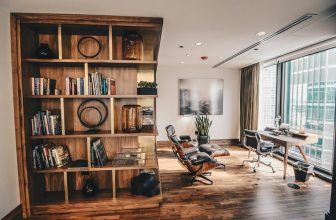
When buying office furniture, your decisions can significantly impact your workspace's functionality and aesthetics. Consider how ergonomics, space planning, budgeting, and design play crucial roles in creating a productive environment. By focusing on these key factors, you can enhance comfort, efficiency, and the overall look of your office space. Keep in mind that each aspect contributes to a well-rounded and conducive work environment, and making informed choices in these areas can lead to a more effective and appealing workspace.
Ergonomics
When buying office furniture, prioritize ergonomics to ensure comfort and productivity in the workplace. Ergonomic furniture is designed to support your body in a way that reduces strain and promotes proper posture.
Look for chairs with adjustable seat height, lumbar support, and armrests to minimize discomfort during long work hours. Your desk should be at a height that allows your arms to rest comfortably while typing, with sufficient legroom underneath.
Investing in ergonomic accessories such as keyboard trays and monitor stands can also enhance your work environment. These tools help to position your equipment at the correct height and angle, reducing the risk of neck and wrist pain.
Pay attention to the layout of your workspace, ensuring that frequently used items are within easy reach to prevent unnecessary stretching or straining. By choosing ergonomically sound furniture and arranging your workspace thoughtfully, you can create a more comfortable and efficient work environment that promotes well-being and productivity.
Space Planning
Considering the layout and size of your office space is crucial when planning the arrangement of your furniture. Before purchasing any pieces, take measurements of the space to ensure that the furniture will fit comfortably without overcrowding the area. Be mindful of the flow of the office and leave enough room for employees to move around freely. Think about the function of each area within the office and choose furniture that complements these functions. For collaborative spaces, consider open layouts with shared desks or tables, while private offices may require more secluded and individualized furniture arrangements.
Maximizing the use of natural light can also play a significant role in space planning. Position desks and workstations near windows to take advantage of natural light, which can boost productivity and create a more pleasant work environment. Additionally, consider the placement of power outlets and technology requirements when planning the layout to ensure easy access and connectivity throughout the office. By carefully planning the space, you can create an office layout that promotes efficiency, collaboration, and comfort for all employees.
Budget Allocation
To effectively allocate your budget for office furniture, prioritize essential pieces that align with your office's functional needs and aesthetic preferences. Begin by identifying the core items required for your workspace, such as desks, chairs, storage units, and meeting tables. Allocate a significant portion of your budget to these key pieces as they form the foundation of your office layout. Consider the quality of these items, as investing in durable furniture can save you money in the long run by reducing the need for frequent replacements.
After securing the necessary foundational pieces, evaluate the remaining budget for additional furnishings or accessories that enhance both the functionality and style of your office. Keep in mind that cost-effective options exist without compromising on quality or design. Compare prices from different suppliers, look for sales or discounts, and consider pre-owned furniture options to maximize your budget allocation.
Design Aesthetics
For an office space that exudes professionalism and style, focus on the design aesthetics of your furniture selection. The design of your office furniture plays a crucial role in creating a welcoming and inspiring work environment. Consider the overall style you want to achieve – whether it's modern and sleek, traditional and elegant, or a creative blend of different aesthetics. Choose furniture pieces that complement the existing decor and reflect your company's brand image.
When selecting office furniture for design aesthetics, pay attention to details such as color, materials, and finishes. Opt for colors that promote productivity and harmony, such as calming blues or energizing greens. Quality materials like solid wood or metal not only enhance the look of the furniture but also ensure durability and longevity. Additionally, consider finishes that are easy to maintain and resistant to wear and tear, keeping your office looking polished and professional.




